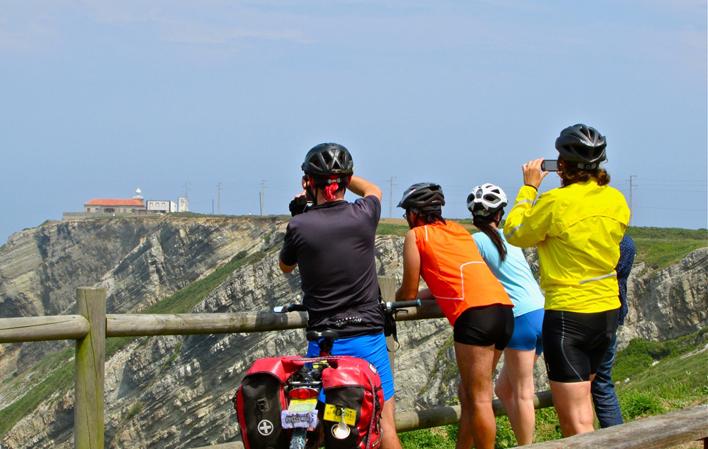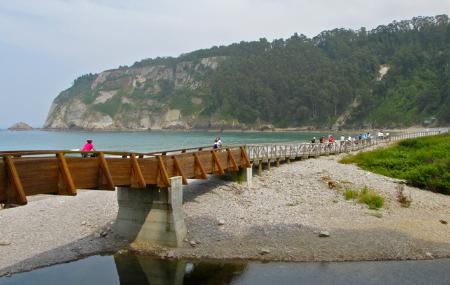
- Address Muros de Nalón and Cudillero Asturias Centre
- Distance Distance: 41,5 kms
- Difficulty Difficulty: High
- Altitude Altitude: 165
- Unevenness Unevenness: 764.62 (rising)
- Mountain bike Mountain bike: 1 day
- Start point Start point: Walls
- Route type Route type: mtb
- Tour type Tour type: Linear
- Layout of the route Layout of the route: Download kml
Muros - El Pito - San Juan - Artedo - San Martín de Luiña - San Cosme - Soto de Luiña - Oviñana - Cabo Vidio - Soto de Luiña - San Martín de Luiña - Artedo - playa de La Concha - Cudillero
Muros del Nalón - Concha de Artedo 41,47
We propose you to enjoy a different kind of day with this "bicipaseo" through the coastal environment of the councils of Muros de Nalón and Cudillero, first visiting Cape Vidio and then spending the afternoon on the beach of La Concha de Artedo.
It will be a linear route starting and finishing at different points, not suitable for all types of bicycles (although there are alternative routes by road), although it should be noted that it is not recommended for people with a low level of physical fitness.
At the starting point of this route, the town of Muros de Nalón, you can walk around the Palacio de Valdecarzana and Vallehermoso. You can also visit the Plaza del Marqués de Muros, from where this town began to grow in the Middle Ages, and admire the Indian style of the town hall and other buildings.
You leave this village by joining the N-632 national road for less than 2 kilometres, practically all of it downhill and with hardly any motorised traffic (most of which is on the dual carriageway). Once you reach La Vana, turn off onto a local road and take the Camino de Santiago del Norte (which you take and leave on several occasions on this route) to enter El Pito, the village that is home to the impressive Quinta de Los Selgas. The Quinta de Los Selgas is a palace and garden estate built in the late 1800s by the Selgas brothers Ezequiel and Fortunato de Selgas. The mansion preserves its original decoration almost intact, and houses paintings by great masters such as Goya and El Greco, along with a varied collection of furniture, textiles, gold and silverware and other curiosities. A neighbouring pavilion displays a collection of tapestries. The gardens are a compendium of European landscaping and are among the most important in Spain.
A short distance away, at the church of Jesús Nazareno, the route continues towards Piñera. It then passes through San Juan and then joins the national road that leads downhill to the village of Artedo. From this village, we start to climb the almost 3 kilometres to San Martín de Luiña, where the route turns off onto the AS-222 to San Cosme. In this town you must turn off to go down rural roads until you reach Práramo, the starting point of a beautiful path that follows the river Esqueiro to Soto de Luiña.
In Soto de Luiña we can see the church of Santa María, with its clock tower. Shortly afterwards, the route continues to climb rapidly along a series of paths and small local roads that lead first to Oviñana and then to the lighthouse at Cabo Vidío.
All the way to the lighthouse, there are several viewpoints with spectacular views of the coastline and the cliffs (almost 100m high) surrounding the cape; you can even see Cape Estaca de Bares and Cape Peñas if the day is clear and there is no mist.
After this stop we return to Soto de Luiña by an alternative route to the outward journey, and after passing this village the route continues by road until we turn off to go to Mumayor along a path, and continue along tracks, paths and local roads (passing under the mega construction of the Artedo viaduct) to the beach of La Concha de Artedo, at which point we recommend you relax: have a swim, eat, have a snack.... Another alternative is to reach the beach by road.
After lunch, the route continues on to Cudillero. It begins with an uphill stretch to the outskirts of Villademar, where we turn off to enjoy a pleasant uphill walk along local roads that will take us to the Cudillero train station, the end point of the route.
As an optional extra, in Cudillero (a fishing village and the capital of the Pixueta) you can go down to the port through its labyrinthine cobbled streets, enjoying a well-deserved end-of-stage refreshment - with portions of sea urchins, curadillos or bígaros - while you enjoy the views of the amphitheatre formed by its houses.




